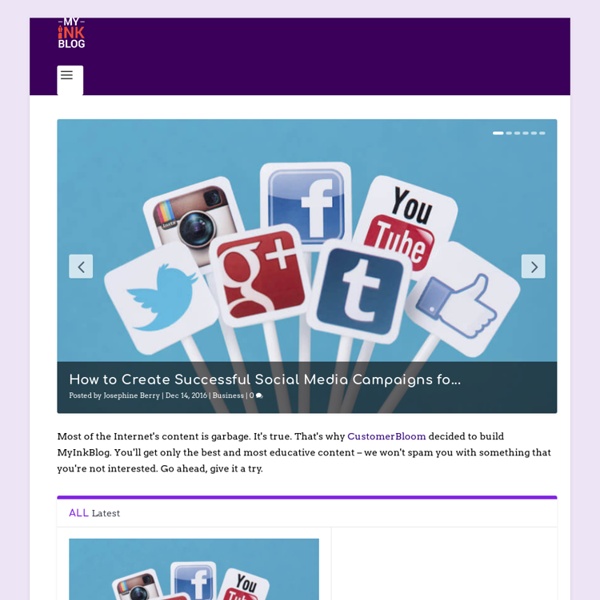



N.Design Blog ← Back to the blog Free MiniCards From Moo.com Aug 07, 2012 1 Comment About the "Building Better Courses" Tutorials This series of tutorials will take you through the basics of building a rapid elearning course. We’ll start with a simple PowerPoint file and publish it. Then we’ll look at what it takes to assemble a good course including some visual design ideas and how to add interactivity. The tutorials include demo videos and none of them are over 5 minutes long.
How to Make a Dark, Post-Apocalyptic City Illustration In this tutorial, we'll change a full of sunshine, ordinary photograph into a gloomy image of the world after destruction of mankind. Using simple tools, we'll turn lively streets into abandoned ruins overgrown with weeds. A number of stock images and a few little tricks will let us optimize our work and make this job more interesting and spectacular. So let's go! Final Image Preview Graphic Design Theory: 50 Resources and Articles As designers, we often focus on the practical aspects of design above all else. We focus on what works, with little regard for why it works. And in our day-to-day work, that outlook serves us well. It lets us get our work done in an efficient, professional manner, and generally nets good results. But spending some time on the theory behind the graphic design principles we use every day can expand our design horizons.
Contrast - Four or More Ways to Use the Principle of Contrast in Graphic Design and Page Layout Contrast is one the principles of design. Contrast occurs when two elements are different. The greater the difference the greater the contrast. The key to working with contrast is to make sure the differences are obvious. 20 Basic Illustrator Tutorials Every Beginner Should See Learning a new software application can be a daunting task, especially when tackling an application that’s as deep as Adobe Illustrator! Thankfully there’s a colection of Illustrator veterans who are generous enough to take the time to document the basics, allowing new users to grasp the initial workings and gain a know-how of the tools and core techniques. This collection of hand-picked tutorials cover various tools, and provide plenty of useful hints and tips. Together they form a super handy resource for any beginner looking to get their brains wrapped around Adobe Illustrator.
Create Custom Characters for Your E-Learning Scenarios Has this happened to you? You’re building an elearning course on site safety and need a woman in a hard hat? Yet when you search your clip art, all you can find is the same people you’ve used in your previous courses. 50 Photoshop Tricks for a Fast-Paced Work Environment Are you a designer on a deadline? If you are, then I’m sure you can recall the last time you thought to yourself, “if I had a little more time, I could…” what? Polish that button? Find a better hero image? Reevaluate that color palette? Here’s Some Background Information for Your Next E-Learning Course During the year I conduct dozens of elearning workshops. I dedicate a large part of the workshop to graphic design because based on what I see, it’s an area that challenges many elearning developers. Most of the people I meet have a training background.
PowerDirector 10 - the world’s fastest video editing software 5-times PC MAG Editors’ Choice Winner – The Best Video Editing Software of the Year PowerDirector has received multiple world-class awards since it’s introduction in September 2013, including the 5th PC Magazine Editors’ choice, CES 2014 CES innovation award. And is selected by PC Magazine as the Best Video Editing Software in 2013. Choose the best video editing software and bring your media creation to a whole new level! Learn More Take Video Creation to a Whole New Level 5 Ways You Can Use Wikis Today I had the privilege to participate in Discovery's Beyond the Textbook forum. One of my take-aways from the day's conversation is that most of the technologies that we want to use to make textbooks interactive and meaningful for students already exist, we just need to organize and utilize them in a way that makes sense for teachers and students. I've combined that take-away with a recent request from a reader to delineate some ways that teachers can use Wikispaces to create this list of ideas for using wikis in classrooms. Please feel free to add your suggestions, with links if possible, in the comments below (please note, I'll be on planes for the next 18 hours so there will be a delay between your comment submission and its appearance on the blog). 1.
A Taxonomy of Reflection: A Model for Critical Thinking My approach to staff development (and teaching) borrows from the thinking of Donald Finkel who believed that teaching should be thought of as “providing experience, provoking reflection.” He goes on to write, … to reflectively experience is to make connections within the details of the work of the problem, to see it through the lens of abstraction or theory, to generate one’s own questions about it, to take more active and conscious control over understanding. ~ From Teaching With Your Mouth Shut Over the last few years I’ve led many teachers and administrators on classroom walkthroughs designed to foster a collegial conversation about teaching and learning.
5 Common Visual Design Mistakes I was working with a student intern the other day. We reviewed his first attempt at a rapid elearning course. For this review, we focused on the course’s visual design. Overall, he did a great job, especially for someone just starting out. However, he made some mistakes that are common to many of the courses I see.